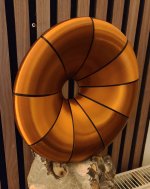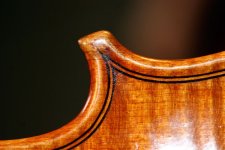A medium CA for the petal pairs and then a quick epoxy for the rest (which is pretty thick).Beautiful! Can I ask what glue you used?
With the spline system I would use a slower epoxy for the petal ring.
👍Generally, pretty good match between your measurements (RED) vs mine (BLUE)
BTW, here's the previous comparison, level-matched (by hand, as I believe is more or less right):

normal = A460
bold = A520G2/25-STD-3
I already showed the (simulated) throat impedances. The difference around 1 kHz could be due to their difference:

At HFs the A460 obviously falls a bit faster, since it's a bit wider (less narrowing).
For the wiggles between 1 - 2 kHz I have no explanation at the moment and it drives me mad 😀
normal = A460
bold = A520G2/25-STD-3
I already showed the (simulated) throat impedances. The difference around 1 kHz could be due to their difference:
At HFs the A460 obviously falls a bit faster, since it's a bit wider (less narrowing).
For the wiggles between 1 - 2 kHz I have no explanation at the moment and it drives me mad 😀
Last edited:
Throat impedances of A460G2 and A520G2 are virtually the same.

(This is including the conical exit section of the driver.)
(This is including the conical exit section of the driver.)
This is a 'quick' 280ex with 9 petals and a 3mm TPU gasket.
It was really easy to squeeze the final piece into place - so there are no gaps at all!
This method is looking promising. Interestingly, its very inert and has no audible resonance at all with the knuckle test. I'm tempted to try softer TPU and a thinner gasket.
It was really easy to squeeze the final piece into place - so there are no gaps at all!
This method is looking promising. Interestingly, its very inert and has no audible resonance at all with the knuckle test. I'm tempted to try softer TPU and a thinner gasket.
Attachments
Last edited:
Hats off, that's really impressive and definitely something to think about. It looks actually pretty simple after all. Was it really? How thick are the petals?
Last edited:
The petals are exactly from your 280ex model. It was really very easy. The only skill is applying the right amount of CA glue. Which got me thinking - perhaps the gasket could be made from those double sided sticky pad things? Some of them are very strong.
But first I'm going to experiment with contact cement, I think that might be less risky, and smells nice. Also, I think a security ring round the rear that is glued in place after the horn is complete would be comforting.
But first I'm going to experiment with contact cement, I think that might be less risky, and smells nice. Also, I think a security ring round the rear that is glued in place after the horn is complete would be comforting.
Maybe the petals could be printed from a "semi-rigid" filament (TPU?) right away, to be always able to "twist" the last joint any way necessary. If used with spline joints, I can't think of anything simpler. Well, I haven't used TPU a lot yet (just some stamp for kids), so I don't know how feasible that is. But I would expect that the harder TPUs are not very difficult to print.
Sure, why not, it looks fabulous. If it's also acoustically inert, what's not to like.
I'm starting to see my next attempt: moderately thin petals from a suitably pliant material with a hard epoxy coat, attached to a base tightened to the driver via rods (like this).
I'm starting to see my next attempt: moderately thin petals from a suitably pliant material with a hard epoxy coat, attached to a base tightened to the driver via rods (like this).
More exploration into 2-way full range MEHs with this weird shape. Just for fun.







That is beautiful. Is there any type of mechanical lock between the spline and the petals (e.g., alignment pins, tongue-grove, etc.) - or are they simply glued on with a little bit of careful hand precision.This is a 'quick' 280ex with 9 petals and a 3mm TPU gasket.
It was really easy to squeeze the final piece into place - so there are no gaps at all!
This method is looking promising. Interestingly, its very inert and has no audible resonance at all with the knuckle test. I'm tempted to try softer TPU and a thinner gasket.
It's been my experience that CA glue works extremely well with PLA, but I also know it can be brittle. With a flexible material like TPU, would CA glue work well?
SMP type glues stay elastic, are relatively easy to handle, full cure time is many hours. Examples: https://www.uhu.com/en-en/products/uhu-max-repair-power-blister-8-g-enplcsskhu https://www.uhu.com/en-en/products/uhu-holz-max-tube-100-g-defrit
Or construction glue, but it can get a bit messy when you apply too much. The advantage is that it fills the gaps and can be easily scraped off before it fully cures.
My experience has been that CA is way stronger than construction adhesives or other flexible glues when it comes to gluing up PLA parts. I've built wood horns using construction adhesives (instead of wood glue) and was super impressed with its application/performance there. I was just not as impressed with construction adhesives and even epoxy with PLA glue-ups. The other thing to keep in mind is that while construction adhesives can work well for loose fitting parts (due to their gap-filling properties), they may not work as well for parts that have a natural tendency to pull apart ---- which is how this specific horn glue up has gone for me. For parts that naturally pull apart, its easier to dab a little CA glue and hold/force the parts together for 20-30 secs, and you are good to go.
@jzagaja I believe that is the case in this design, yes. I purposely put the taps in the "valleys" to see if I could observe what effects the taps would have off-axis, and it seems that they result in some narrowing.
When I set up observation fields in akabak, I could also see that sound energy was higher in the valleys at pretty much all frequencies.

The A/B comparison test will now be to print another version with the taps placed at the "peaks" and see if that resolves it.
When I set up observation fields in akabak, I could also see that sound energy was higher in the valleys at pretty much all frequencies.
The A/B comparison test will now be to print another version with the taps placed at the "peaks" and see if that resolves it.
- Home
- Loudspeakers
- Multi-Way
- Acoustic Horn Design – The Easy Way (Ath4)

